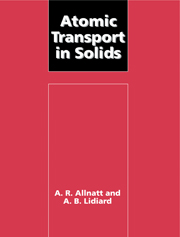Book contents
- Frontmatter
- Contents
- Preface
- List of principal symbols
- 1 Atomic movements in solids – phenomenological equations
- 2 Imperfections in solids
- 3 Statistical thermodynamics of crystals containing point defects
- 4 Non-equilibrium thermodynamics of atomic transport processes in solids
- 5 Some applications of non-equilibrium thermodynamics to solids
- 6 Microscopic theories – the master equation
- 7 Kinetic theory of relaxation processes
- 8 Kinetic theory of isothermal diffusion processes
- 9 The theory of random walks
- 10 Random-walk theories of atomic diffusion
- 11 Transport coefficients of dilute solid solutions – results and applications
- 12 The evaluation of nuclear magnetic relaxation rates
- 13 Theories of concentrated and highly defective systems
- References
- Index
3 - Statistical thermodynamics of crystals containing point defects
Published online by Cambridge University Press: 28 December 2009
- Frontmatter
- Contents
- Preface
- List of principal symbols
- 1 Atomic movements in solids – phenomenological equations
- 2 Imperfections in solids
- 3 Statistical thermodynamics of crystals containing point defects
- 4 Non-equilibrium thermodynamics of atomic transport processes in solids
- 5 Some applications of non-equilibrium thermodynamics to solids
- 6 Microscopic theories – the master equation
- 7 Kinetic theory of relaxation processes
- 8 Kinetic theory of isothermal diffusion processes
- 9 The theory of random walks
- 10 Random-walk theories of atomic diffusion
- 11 Transport coefficients of dilute solid solutions – results and applications
- 12 The evaluation of nuclear magnetic relaxation rates
- 13 Theories of concentrated and highly defective systems
- References
- Index
Summary
Introduction
In the previous chapter we surveyed the ideas of point defects which form the physical basis for the description of diffusion and other atomic transport phenomena. In the present chapter we shall describe the application of equilibrium statistical mechanics to these physical models under conditions of thermodynamic equilibrium. This will allow us to obtain the contributions of thermally created point defects to thermodynamic quantities, e.g. lattice expansions, specific heat, etc. But there is a wider interest in such calculations, as will be fully apparent in later chapters. For, although the processes of atomic transport involve systems not in overall thermodynamic equilibrium, the theory of these processes nevertheless assumes the existence of local thermodynamic equilibrium; i.e. of equilibrium in regions small compared to the size of the entire macroscopic specimen but large enough to allow a thermodynamic description locally. There are two aspects to this, one concerns the chemical potentials μi and the other the transport coefficients, Lij (cf. §1.4). Statistical thermodynamics allows us to calculate the chemical potentials of the various components, i, of any particular model system as functions of the intensive thermodynamic variables. Gradients of these chemical potentials then give the thermodynamic forces Xi which generate the fluxes of atoms, defects, etc. under non-equilibrium conditions. For the transport coefficients we shall need the equilibrium concentrations of point defects and certain related quantities. Statistical thermodynamics again will provide these for particular models as a function of thermodynamic variables (e.g. P, T) without regard to the mechanism by which this equilibrium is attained (although, of course, it is implicit that the density of defect sinks and sources is adequate).
- Type
- Chapter
- Information
- Atomic Transport in Solids , pp. 92 - 160Publisher: Cambridge University PressPrint publication year: 1993



